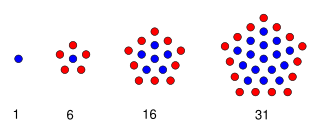15 (fifteen) is the natural number following 14 and preceding 16.
19 (nineteen) is the natural number following 18 and preceding 20. It is a prime number.
90 (ninety) is the natural number following 89 and preceding 91.
23 (twenty-three) is the natural number following 22 and preceding 24.
25 (twenty-five) is the natural number following 24 and preceding 26.
32 (thirty-two) is the natural number following 31 and preceding 33.
31 (thirty-one) is the natural number following 30 and preceding 32. It is a prime number.
63 (sixty-three) is the natural number following 62 and preceding 64.
1000 or one thousand is the natural number following 999 and preceding 1001. In most English-speaking countries, it can be written with or without a comma or sometimes a period separating the thousands digit: 1,000.
600 is the natural number following 599 and preceding 601.
147 is the natural number following 146 and preceding 148.

In mathematics, a centered pentagonal number is a centered figurate number that represents a pentagon with a dot in the center and all other dots surrounding the center in successive pentagonal layers. The centered pentagonal number for n is given by the formula
124 is the natural number following 123 and preceding 125.

A centered decagonal number is a centered figurate number that represents a decagon with a dot in the center and all other dots surrounding the center dot in successive decagonal layers. The centered decagonal number for n is given by the formula
181 is the natural number following 180 and preceding 182.
252 is the natural number following 251 and preceding 253.
In mathematics, the Schröder number also called a large Schröder number or big Schröder number, describes the number of lattice paths from the southwest corner of an grid to the northeast corner using only single steps north, northeast, or east, that do not rise above the SW–NE diagonal.

In mathematics, a centered octahedral number or Haüy octahedral number is a figurate number that counts the points of a three-dimensional integer lattice that lie inside an octahedron centered at the origin. The same numbers are special cases of the Delannoy numbers, which count certain two-dimensional lattice paths. The Haüy octahedral numbers are named after René Just Haüy.
In mathematics, a centered dodecahedral number is a centered figurate number that represents a dodecahedron. The centered dodecahedral number for a specific n is given by
In mathematics, an icosahedral number is a figurate number that represents an icosahedron. The nth icosahedral number is given by the formula





